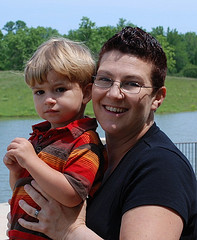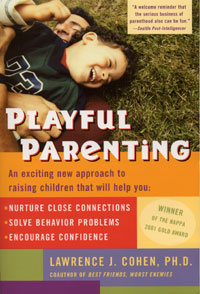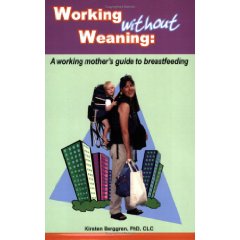By Rita Brhel, managing editor and attachment parenting resource leader (API)
 Georgia Jones isn’t accustomed to addressing a crowd as knowledgeable about food as are many attached parents. An University of Nebraska-Lincoln nutrition professor, Jones spends much of her classroom time educating people about the very basics of what they put in their bodies.
Georgia Jones isn’t accustomed to addressing a crowd as knowledgeable about food as are many attached parents. An University of Nebraska-Lincoln nutrition professor, Jones spends much of her classroom time educating people about the very basics of what they put in their bodies.
“My students don’t come with an understanding of food,” she said. “Food for my students comes out of a box, a pan. If I told my students to go make a chocolate cake, they wouldn’t have a clue.”
But many families involved in Attachment Parenting are smart about their food. They understand the importance of knowing where their food comes from and how it was produced. These consumers choose to eat food without chemicals, because they realize that organic is superior to conventionally raised food. Or, is it?
Background on the Organic Food Industry
Organic food, a $14 billion industry, is the fastest-growing segment of the food industry, Jones said. National surveys show that two-thirds of Americans have purchased organic food at some point during the last 12 months.
“Organic food started as mostly a niche market, years ago,” Jones said. During especially the last decade, organic foods, farmers markets, and local food networks have spread rapidly into the mainstream consumer market. “Organic food is no longer a niche market,” she said.
Consumer demand for organic food is on the rise for a number of reasons, including food safety issues, such as an avoidance of pesticides and genetically modified organisms (GMOs); a concern for the environment; and because organic food is often fresher and tastier than conventionally grown food, Jones said. But the number-one reason is an increased awareness of the link between food and health.
“There was a time in this country when we forgot that food actually has a purpose in our health, that it is for nourishment,” Jones said. “Now, we’ve moved into an area that I call ‘beyond nutritional eating,’ where we are using food to try to prevent and heal disease.”
That organic food is free of pesticides and GMOs and comes from environmentally friendly farms and gardens are safe assumptions – each documented through federally regulated certification programs. Shocking as it may be, however, there is no certainty that organic food, while its safety is certainly more accountable, is actually more nutritious than conventionally grown food, Jones said.
A New Era in Food Science
Consumers often confuse food safety and nutrition. Food-borne illnesses, pesticides, and GMO allergens are food safety concerns. Nutrition refers specifically to the content of macro- and micronutrients within food. Traditional nutrition centers on macronutrients, which include protein, carbohydrates, and fats; vitamins; and minerals. Micronutrients include substances such as phytochemicals and phytonutrients that were long thought to have no effect on human health. Research now shows that these micronutrients, also known as secondary metabolites, are extremely beneficial in boosting the immune system, protecting the body from cancer-causing free radicals, killing disease-causing pathogens, and more. “This is a new area [for science],” Jones said.
One phytonutrient receiving a lot of attention from nutritionists are flavonoids, which are found in very high amounts in blueberries but also in a variety of colorful fruits and vegetables. Flavonoids are known to protect against heart disease, cancer, and age-related diseases such as dementia. “You want to eat plenty of fruits and plenty of vegetables,” Jones said. “Something else is, you want to eat plenty of color. This is a key part of nutrition and is not getting enough attention.”
Activated by environmental stress, flavonoids are produced by the plant as a defense mechanism against UV-B radiation and disease stress. “These secondary metabolites aren’t there for us. We just reap the benefits,” Jones said. “They’re actually there to protect the plant.”
Organic Plants Contain More Secondary Metabolites
To determine whether organically raised plants are more nutritious than conventionally raised plants, science is going back to how plants are raised and focusing on the formation of secondary metabolites — the phytonutrients — which are chemicals produced by a plant grown in less-than-ideal conditions. Organically raised plants are subject to more pest and weather stress than conventionally raised plants, which are protected by chemical pesticides, GMO varieties, and commercial fertilizer application. As a result of this added stress, an organically raised plant produces secondary metabolites to provide added protection, as well as to quicken maturation and seed development.
But Theories Are Not Proof
Although organic foods do tend to contain more secondary metabolites, “there are a number of reasons why scientists aren’t coming out and saying this is the better way,” Jones said. There are still too many unknowns in the formation of secondary metabolites, including specific environmental factors, soil properties, and crop management practices that affect the formation of these micronutrients. Plus, there are two crucial questions that must be answered first:
- Do organic plant products contain more or less of certain nutrients, minerals, vitamins, and secondary metabolites than conventional plant products?
- To what extent are nutrients, minerals, vitamins, and secondary metabolites beneficial or harmful to human health?
Much of the problem with being unable to give a definite answer to the question of whether organic food is more nutrition relates to the type of research that has been conducted on the relationship between secondary metabolites and organically raised food. Most of the studies seek out theories, such as epidemiological studies that link food to health through statistics, retail food analysis, and other studies that are purely observational. Observational studies look for patterns, but they can’t prove a theory. For example, an observational study may find that people who eat oranges tend not to develop cancer but there aren’t any scientific data to prove that oranges prevent cancer. “Just because something organic is statistically different doesn’t mean it’s biologically different,” Jones said.
Below are a number of observational studies related to organic nutrition, each with promising theories:
- Organic ketchup contains more lycopene than conventional and store brands, and fast food ketchup (Ishida and Chapman, 2009).
- Flavanoids are significantly higher in tomatoes raised with organic practices such as crop rotation for pest control and organic matter for fertilizer, than in tomatoes raised with herbicides and pesticides and commercial fertilizer (Mitchell et al, 2007).
- Animals fed with organic feeds have fewer stillbirths than those fed with conventional feeds (Williams, 2002; Bourn and Prescott, 2003).
- Antioxidant compounds are higher in peaches and pears raised organically than conventionally, and vitamin E is higher in organic pears than conventional pears (Carbonaro, et al, 2002).
- Organic food products have higher levels of vitamin C and lower levels of nitrates than conventional food products (Bourn and Prescott, 2002).
A follow-up human or animal study must be used to prove any theories found. Human studies are the most influential but are particularly difficult to do. “You can control what a rat does, but you can’t control what a human does,” Jones said. “You have to consider not only diet but lifestyle. You can’t eat organic and drink or smoke all day. … You also have to consider, with human studies, that diseases progress over a lifespan, not just one or two years.”
The Most Promising Study
By and large, the observational study most supportive of the theory that organic food is nutritionally superior to conventional foods was conducted in 2001 among Okinawans, the people living on the southern-most Japanese island of Okinawa.
“They have the longest lifespan of any group alive,” Jones said. Okinawans live to be an average of 81.2 years old, followed by the Japanese at 79.9 years, Hong Kong at 79.1 years, and Sweden at 79.0 years. The United States has the 18th longest lifespan of the world’s societies, at 76.8 years.
Okinawans also experience a delayed aging process and minimized debilitating diseases in the elder years. “These people are healthier longer than (Americans) are,” Jones said, despite U.S. medical advancements superior to that of the Okinawans. The average cholesterol level in the Okinawa centenarian is 102.4 mg/dL, and high blood pressure exists in only 1.5% of the centenarian population, she said.
There are several aspects of the Okinawan diet that differ dramatically from the Western diet. Okinawans have never developed a taste for salt, so “they don’t eat a lot of processed foods,” Jones said. Their flavonoid consumption is six times higher than the Japanese or Canadians, who are next on the list. And the Okinawan diet contains the highest lycopene content of all of the world’s diets. The Okinawan diet has since been called the Longevity Diet, because it improves physical strength, prevents illness, and maintains overall health.
“They look at medicine as food,” Jones said. “They’re really looking at food in a different manner than we do.”
Using the Okinawan study, consumers of organic foods can safely assume that, yes, organic is nutritionally superior to conventional foods, Jones said. But, she warned, this is only a guess until the research proves it so — although it’s a guess that many consumers are confident to say is truth.
Current Trends in the Organic Sector
Consumer interest in organic foods continued to grow last year. Highlights from 2008 consumer use surveys include:
- Research from The Natural Marketing Institute reveals that consumers are increasingly incorporating organic products into their lifestyles. Total household penetration across six product categories has risen from 57% in 2006 to 59% in 2007. The research also showed that the number of core users has increased from 16% in 2006 to 18% in 2007.
- Consumer interest in buying environmentally friendly products and organic food remains high among Northwest natural and organic product consumers despite tough economic times and rising food and energy prices. Research by Mambo Sprouts Marketing showed that consumers in Washington and Oregon see buying “green” as a priority: 92% of consumers reported buying the same (54%) or more (38%) environmentally friendly products compared to the prior six months. Rather than cutting out such products, consumers report they are using money-saving strategies, such as coupons, stocking up on sales, and cooking meals at home to stretch their grocery dollars.
- 69% of U.S. adult consumers buy organic products at least occasionally, according to The Hartman Group report, The Many Faces of Organic 2008. Furthermore, about 28% of organic consumers (about 19% adults) are weekly organic users. Organic categories of high interest to consumers are dairy, fruit and vegetables, prepared foods, meats, breads, and juices.
- A Harris Interactive online survey conducted for Whole Foods Market showed that, despite rising food prices, 79% of consumers do not want to compromise on food quality and 70% continue to buy the same amount of natural and organic foods. Findings also showed two out of three adults prefer to buy natural or organic products if prices are comparable to those of non-organic products. Overall, the survey found that 74% of adults purchase natural or organic foods, with 20% saying that more than one-fourth of all the groceries they buy are natural or organic. In addition, 66% of adults would like to find ways to buy natural or organic foods within their budget.
“Grant me the serenity to accept the things I cannot change; courage to change the things I can; and wisdom to know the difference.”
 A cup of hot cocoa, a bubble bath, a cozy blanket, a cuddle with a fluffy dog, a steamy bowl of soup, a tuck into bed — all of these are warm, but none compares to a snuggle with someone we love and who loves us. And this is especially true for Sophie, the little girl whose story is told in The Warmest Place of All, a new children’s book by Licia Rando, M.Ed, illustrated by Anne Jewett. After trying comfort after comfort, Sophie climbs into bed with her mother and father and discovers a true sense of peace and wholeness.
A cup of hot cocoa, a bubble bath, a cozy blanket, a cuddle with a fluffy dog, a steamy bowl of soup, a tuck into bed — all of these are warm, but none compares to a snuggle with someone we love and who loves us. And this is especially true for Sophie, the little girl whose story is told in The Warmest Place of All, a new children’s book by Licia Rando, M.Ed, illustrated by Anne Jewett. After trying comfort after comfort, Sophie climbs into bed with her mother and father and discovers a true sense of peace and wholeness.
 This week, though, I’ve been rereading Playful Parenting by Lawrence Cohen. So last night when Cavanaugh was rolling around, being silly, asking for more of me than I had, I tried something — to playfully set the boundary. I told him, in a funny tone, that it was time to go to bed and wagged my index finger at him. My anger gave in to silliness, he was laughting, and the impending power struggle dissipated. After a couple more minutes of playing, he turned over to go to sleep. I got to tell him the limit was firm without having to use firm tones. And he got exactly what he needed, a reconnection as I looked into his eyes and acted a clown.
This week, though, I’ve been rereading Playful Parenting by Lawrence Cohen. So last night when Cavanaugh was rolling around, being silly, asking for more of me than I had, I tried something — to playfully set the boundary. I told him, in a funny tone, that it was time to go to bed and wagged my index finger at him. My anger gave in to silliness, he was laughting, and the impending power struggle dissipated. After a couple more minutes of playing, he turned over to go to sleep. I got to tell him the limit was firm without having to use firm tones. And he got exactly what he needed, a reconnection as I looked into his eyes and acted a clown.
 The first painful hurdle I was to face as a mother was the need to return to work. After a three-month crash course in Attachment Parenting (AP), my daughter and I were well bonded, so going back to work broke my heart. I have to admit it still does — every day that I spend more time working for a paycheck than I do building a relationship with my daughter, I cry a little privately.
The first painful hurdle I was to face as a mother was the need to return to work. After a three-month crash course in Attachment Parenting (AP), my daughter and I were well bonded, so going back to work broke my heart. I have to admit it still does — every day that I spend more time working for a paycheck than I do building a relationship with my daughter, I cry a little privately. It’s dinnertime somewhere. Families sit around a dining table, or gather around a short-legged table, or settle on a rug in a circle. A baby may be in a high chair or on his mother’s back, having food handed to him. He may be in a hammock, gently pushed every so often, dozing, not eating, and absorbing the sounds of his family enjoying their evening meal.
It’s dinnertime somewhere. Families sit around a dining table, or gather around a short-legged table, or settle on a rug in a circle. A baby may be in a high chair or on his mother’s back, having food handed to him. He may be in a hammock, gently pushed every so often, dozing, not eating, and absorbing the sounds of his family enjoying their evening meal. Many women find themselves pregnant while they are still enjoying a nursing relationship with their child. It doesn’t typically occur during the first six months, as long as you and your child are together most of the time and the child is exclusively nursing, but it can happen any time. Your child may be seven months or two years old when you discover you are pregnant. Should pregnancy be the reason to wean? For most mothers, the answer is a resounding no!
Many women find themselves pregnant while they are still enjoying a nursing relationship with their child. It doesn’t typically occur during the first six months, as long as you and your child are together most of the time and the child is exclusively nursing, but it can happen any time. Your child may be seven months or two years old when you discover you are pregnant. Should pregnancy be the reason to wean? For most mothers, the answer is a resounding no! Did you ever think you would be considering nursing two children at the same time? Probably most of us haven’t thought about that, but many women have done it. Known as tandem nursing, it happens all the time with twins and triplets but can be done also be done with children of different ages – for example, nursing your newborn while continuing to nurse your toddler.
Did you ever think you would be considering nursing two children at the same time? Probably most of us haven’t thought about that, but many women have done it. Known as tandem nursing, it happens all the time with twins and triplets but can be done also be done with children of different ages – for example, nursing your newborn while continuing to nurse your toddler. My experience with weaning my daughter was very successful and non-traumatic, which was a good thing since I found it hard to imagine how I would ever refuse her.
My experience with weaning my daughter was very successful and non-traumatic, which was a good thing since I found it hard to imagine how I would ever refuse her. Georgia Jones isn’t accustomed to addressing a crowd as knowledgeable about food as are many attached parents. An University of Nebraska-Lincoln nutrition professor, Jones spends much of her classroom time educating people about the very basics of what they put in their bodies.
Georgia Jones isn’t accustomed to addressing a crowd as knowledgeable about food as are many attached parents. An University of Nebraska-Lincoln nutrition professor, Jones spends much of her classroom time educating people about the very basics of what they put in their bodies.